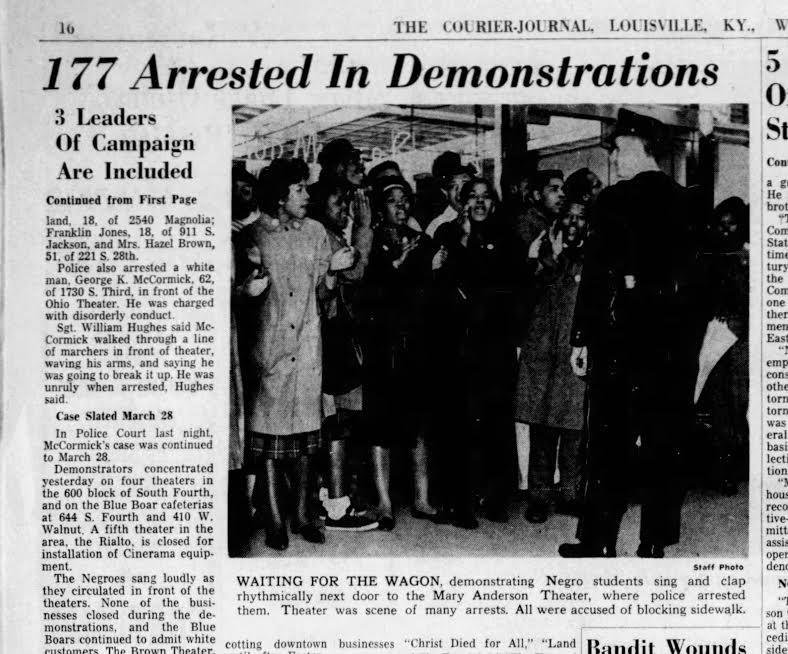Mary Anderson Theater Demonstration Site
Introduction
Text-to-speech Audio
The Mary Anderson Theater was opened in 1907 and in the 1920s was converted to a film theater. This theater was regularly busy which is why it became a site for civil rights demonstrations. Protesters knew this would be an ideal location to bring publicity and attention to their cause. 1961 is when most demonstrations took place in downtown Louisville in the wake of the Greensboro and Nashville sit-ins.
Images
Students arrested outside the Mary Anderson Theater wait for the wagon to take them.

Backstory and Context
Text-to-speech Audio
The Mary Anderson Theater was a popular theater for downtown and suburban Louisville residents. It was opened in 1907 as a vaudeville house. In the 1920s it was converted to a film theater where it showed many popular films over the 20th century, especially Warner Brothers films. It was named after the famous Hollywood actress born in Louisville, Mary Anderson.
Although the theater closed in the early 1970s, it was a location in the 1960s that for many was a place of struggle and of hope. African Americans dreamed of being admitted to the theater to watch upcoming films but were constantly denied due to Jim Crow practices. This particular business was targeted because of its high visibility downtown. Protest organizers knew that publicity and newspaper coverage would sway public opinion and to eventually give them admittance to the theater. Because this theater was constantly busy, it made it an ideal location for African-Americans to conduct their demonstrations.
Students would usually walk around outside singing songs of liberation, holding signs, or just sit on the sidewalk. Many individuals were arrested regularly for demonstrating and usually charged with either disturbing the peace or blocking the sidewalk. The theater remained open during demonstrations so their cause always had an audience. For example, on February 23, 1961, demonstrations were held across downtown Louisville. Six teenagers were arrested at the Mary Anderson Theater for disorderly conduct and delinquency. In response to the protests, a number of businesses agreed to curb Jim Crow practices, and the campaign was considered a success.
Although the theater closed in the early 1970s, it was a location in the 1960s that for many was a place of struggle and of hope. African Americans dreamed of being admitted to the theater to watch upcoming films but were constantly denied due to Jim Crow practices. This particular business was targeted because of its high visibility downtown. Protest organizers knew that publicity and newspaper coverage would sway public opinion and to eventually give them admittance to the theater. Because this theater was constantly busy, it made it an ideal location for African-Americans to conduct their demonstrations.
Students would usually walk around outside singing songs of liberation, holding signs, or just sit on the sidewalk. Many individuals were arrested regularly for demonstrating and usually charged with either disturbing the peace or blocking the sidewalk. The theater remained open during demonstrations so their cause always had an audience. For example, on February 23, 1961, demonstrations were held across downtown Louisville. Six teenagers were arrested at the Mary Anderson Theater for disorderly conduct and delinquency. In response to the protests, a number of businesses agreed to curb Jim Crow practices, and the campaign was considered a success.
